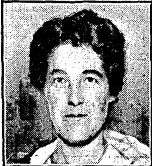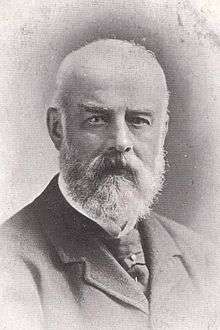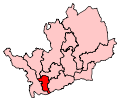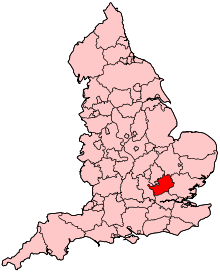Watford (UK Parliament constituency)
| Watford | |
|---|---|
|
Borough constituency for the House of Commons | |
|
Boundary of Watford in Hertfordshire. | |
|
Location of Hertfordshire within England. | |
| County | Hertfordshire |
| Electorate | 80,939 (December 2010)[1] |
| Current constituency | |
| Created | 1885 |
| Member of parliament | Richard Harrington (Conservative) |
| Number of members | One |
| Created from | Hertfordshire |
| Overlaps | |
| European Parliament constituency | East of England |
Watford is a constituency[n 1] represented in the House of Commons of the UK Parliament since 2010 by Richard Harrington, a member of the Conservative Party.[n 2]
History
Before the Redistribution of Seats Act 1885 the area was part of the three seat constituency of Hertfordshire. Upon this act, it took up the western division of the county, however later seats such as South West Hertfordshire, established in 1950 have reduced its reach, as settlements in those areas, and Watford itself, have grown.
- Political history
The seat has been a bellwether of the national result since February 1974. Watford saw considerable Liberal Democrat opposition in 2005, achieving second place, taking many Labour votes with the Conservative candidate close behind.[2]
Before the 2010 general election it was a three-way marginal seat in which local Tories, Labour supporters and Liberal Democrats aimed to garner support for their candidate. This election in Watford was won by Richard Harrington (Con) with 34.9% of the vote. The Liberal Democrats narrowly missed out on the seat with 32.4% of the vote and the defeat for Labour's candidate, Claire Ward, was a pronounced change with 26.7% of the vote.[3]
- Prominent frontbenchers
Dennis Herbert was Deputy Speaker from 1931-1943.
Major John Freeman was only a third-tier (junior) minister in the War Office as MP. His later unusually prominent positions in diplomacy led to his being appointed a member of the Privy Council and thereby being Rt Hon as of 1966.
Tristan Garel-Jones was Minister for Europe for three years of the Major ministry.
Both Herbert and Garel-Jones opted as peers in later life to use Watford as the territorial designation of their peerages.
Boundaries
1885-1918: Parts of the Sessional Division of Watford and Dacorum.
1918-1950: The Urban Districts of Bushey, Chorleywood, Rickmansworth, and Watford, and part of the Rural District of Watford.
1950-1983: The Municipal Borough of Watford.
1983-1997: The Borough of Watford, the District of Three Rivers wards of Abbots Langley and Leavesden, and the City of St Albans wards of Park Street and St Stephens.
1997-present: The Borough of Watford, and the District of Three Rivers wards of Abbots Langley, Carpenders Park, Langleybury, Leavesden, and Oxhey Hall.
The constituency comprises the whole of the Borough of Watford, together with five wards from Three Rivers District. Two of the Three Rivers wards, Carpenders Park and Oxhey Hall, are to the south of Watford town and include mostly prosperous, elevated, commuter villages. The remaining three, Abbots Langley, Langleybury and Leavesden, are to the north of Watford, the first of which is a large village, and due to its relative remoteness from the City of London is mixed in character and levels of income.[4]
Constituency profile
Watford has a considerable service sector economy, with several notable headquarters, and engineering, trade-craft and distribution in its economy, however is also a commuter town to the City of London. British Waterways, J D Wetherspoon, Camelot Group, Iveco, manufacturers of commercial vehicles; part of Balfour Beatty; Bathstore, the largest bathroom retailer in the UK; construction firm Taylor Woodrow; and Mothercare are the largest of these. The borough is also the UK base of many multinationals including C.H. Robinson, Total Oil, TK Maxx, Costco, Vinci and Beko appliances. International golf tournaments such as the 2006 World Golf Championship have taken place at the Grove hotel.
Workless claimants who were registered jobseekers were in November 2012 lower than the national average of 3.8%, at 3.0% of the population based on a statistical compilation by The Guardian.[5]
Members of Parliament
| Election | Member[6] | Party | Notes | |
|---|---|---|---|---|
| 1885 | Frederick Halsey | Conservative | ||
| 1906 | Nathaniel Micklem QC | Liberal | ||
| 1910 | Arnold Sandwith Ward | Conservative | ||
| 1918 | Dennis Herbert | Conservative | Deputy Speaker (1931-1943) | |
| 1943 by-election | William Helmore | Conservative | ||
| 1945 | Major John Freeman | Labour | High Commissioner to India (1965–1968) Ambassador to the U.S. (1969–1971) | |
| 1955 | Frederick Farey-Jones | Conservative | ||
| 1964 | Raphael Tuck | Labour | ||
| 1979 | Tristan Garel-Jones | Conservative | Minister for Europe (1990-1993) | |
| 1997 | Claire Ward | Labour | ||
| 2010 | Richard Harrington | Conservative | Minister for Syrian Refugees (2015-) | |
Elections
Elections in the 2010s
| Party | Candidate | Votes | % | ± | |
|---|---|---|---|---|---|
| Conservative | Richard Harrington | 24,400 | 43.5 | +8.5 | |
| Labour | Matthew Turmaine | 14,606 | 26.0 | -0.7 | |
| Liberal Democrat | Dorothy Thornhill | 10,152 | 18.1 | -14.3 | |
| UKIP | Nick Lincoln | 5,481 | 9.8 | +7.6 | |
| Green | Aidan Cottrell-Boyce | 1,332 | 2.4 | +0.8 | |
| Trade Unionists and Socialists Against Cuts | Mark O'Connor | 178 | 0.3 | +0.3 | |
| Majority | 9,794 | 17.4 | +14.8 | ||
| Turnout | 56,149 | 66.6 | -1.7 | ||
| Conservative hold | Swing | 4.6 | |||
| Party | Candidate | Votes | % | ± | |
|---|---|---|---|---|---|
| Conservative | Richard Harrington | 19,291 | 34.9 | +5.3 | |
| Liberal Democrat | Sal Brinton[n 3] | 17,866 | 32.4 | +1.1 | |
| Labour | Claire Ward | 14,750 | 26.7 | -6.8 | |
| BNP | Andrew Emerson | 1,217 | 2.2 | +2.2 | |
| UKIP | Graham Eardley | 1,199 | 2.2 | -0.4 | |
| Green | Ian Brandon | 885 | 1.6 | -1.4 | |
| Majority | 1,425 | 2.6 | |||
| Turnout | 55,208 | 68.3 | +3.4 | ||
| Conservative gain from Labour | Swing | 6.05 | |||
- Background to Conservative candidates
In July 2007 former candidate Ali Miraj, a candidate for Aberavon in 2001, was dropped from the candidates list by the Conservative party after he complained about David Cameron's leadership style and allegedly demanded a peerage.[11][12] The public selected his former campaign manager Ian Oakley, who had been a candidate for Newport East in 2001 in the first Open Primary to be organised by the Conservative Party in November 2006. In July 2008, Oakley, withdrew candidature after being arrested for conducting a campaign of harassment against the local Liberal Democrats,[13][14] for which he was convicted and given an 18-week suspended prison sentence and 12 month supervision order on 13 October 2008.[15]
In December 2008 Watford Conservative Association selected a new candidate, Richard Harrington.[16]
Elections in the 2000s
| Party | Candidate | Votes | % | ± | |
|---|---|---|---|---|---|
| Labour | Claire Ward | 16,575 | 33.6 | −11.7 | |
| Liberal Democrat | Sal Brinton | 15,427 | 31.2 | +13.8 | |
| Conservative | Ali Miraj | 14,634 | 29.6 | −3.7 | |
| Green | Steve Rackett | 1,466 | 3.0 | +1.1 | |
| UKIP | Kenneth Wight | 1,292 | 2.6 | +1.4 | |
| Majority | 1,148 | 2.3 | |||
| Turnout | 49,394 | 64.8 | +3.7 | ||
| Labour hold | Swing | -12.8 | |||
| Party | Candidate | Votes | % | ± | |
|---|---|---|---|---|---|
| Labour | Claire Ward | 20,992 | 45.3 | 0.0 | |
| Conservative | Michael McManus | 15,437 | 33.3 | -1.5 | |
| Liberal Democrat | Duncan Hames | 8,088 | 17.4 | +0.7 | |
| Green | Denise Kingsley | 900 | 1.9 | N/A | |
| UKIP | Edmund Stewart-Mole | 535 | 1.2 | N/A | |
| Socialist Alliance | Jon Berry | 420 | 0.9 | N/A | |
| Majority | 5,555 | 12.0 | |||
| Turnout | 46,372 | 61.1 | -13.5 | ||
| Labour hold | Swing | ||||
Elections in the 1990s
[17]| Party | Candidate | Votes | % | ± | |
|---|---|---|---|---|---|
| Labour | Claire Ward | 25,109 | 45.3 | +11.3 | |
| Conservative | Robert Ian Neilson Gordon | 19,227 | 34.8 | -13.3 | |
| Liberal Democrat | Andrew James Canning | 9,272 | 16.8 | +0.0 | |
| Referendum | Philip Edward Roe | 1,484 | 2.7 | N/A | |
| Natural Law | Leslie James Kenneth Davis | 234 | 0.4 | N/A | |
| Majority | 5,792 | 10.5 | |||
| Turnout | 55,236 | 74.6 | |||
| Labour gain from Conservative | Swing | ||||
| Party | Candidate | Votes | % | ± | |
|---|---|---|---|---|---|
| Conservative | Tristan Garel-Jones | 29,072 | 48.8 | +0.1 | |
| Labour | Michael J. Jackson | 19,482 | 32.7 | +4.5 | |
| Liberal Democrat | Mark Oaten | 10,231 | 17.2 | −5.9 | |
| Green | Jeremy Hywel-Davies | 566 | 1.0 | N/A | |
| Natural Law | Leslie James Kenneth Davis | 176 | 0.3 | N/A | |
| Majority | 9,590 | 16.1 | −4.4 | ||
| Turnout | 59,527 | 82.3 | +4.4 | ||
| Conservative hold | Swing | −2.2 | |||
Elections in the 1980s
| Party | Candidate | Votes | % | ± | |
|---|---|---|---|---|---|
| Conservative | Tristan Garel-Jones | 27,912 | 48.7 | ||
| Labour | Michael John Jackson | 16,176 | 28.2 | ||
| Social Democratic | Fiona Mary Beckett | 13,202 | 23.1 | ||
| Majority | 11,736 | 20.5 | |||
| Turnout | 77.9 | ||||
| Conservative hold | Swing | ||||
| Party | Candidate | Votes | % | ± | |
|---|---|---|---|---|---|
| Conservative | Tristan Garel-Jones | 26,273 | 47.95 | ||
| Social Democratic | P. Burton | 14,267 | 26.04 | ||
| Labour | I. Wilson | 14,247 | 26.00 | ||
| Majority | 12,006 | 21.91 | |||
| Turnout | 76.10 | ||||
| Conservative hold | Swing | ||||
Elections in the 1970s
| Party | Candidate | Votes | % | ± | |
|---|---|---|---|---|---|
| Conservative | Tristan Garel-Jones | 21,320 | 47.64 | ||
| Labour | Tony Banks | 18,030 | 40.28 | ||
| Liberal | B Bodle | 5,019 | 11.21 | ||
| National Front | Brent Cheetham | 388 | 0.87 | ||
| Majority | 3,290 | 7.35 | |||
| Turnout | 44,757 | 81.26 | |||
| Conservative gain from Labour | Swing | ||||
| Party | Candidate | Votes | % | ± | |
|---|---|---|---|---|---|
| Labour | Raphael Herman Tuck | 19,177 | 44.28 | ||
| Conservative | Tristan Garel-Jones | 15,220 | 35.14 | ||
| Liberal | David Anthony Jacobs | 8,243 | 19.03 | ||
| National Front | Jeremy Wotherspoon | 671 | 1.55 | ||
| Majority | 3,957 | 9.14 | |||
| Turnout | 77.3 | ||||
| Labour hold | Swing | ||||
| Party | Candidate | Votes | % | ± | |
|---|---|---|---|---|---|
| Labour | Raphael Herman Tuck | 18,884 | 40.47 | ||
| Conservative | David W. Clarke | 16,089 | 34.48 | ||
| Liberal | David Anthony Jacobs | 11,035 | 23.65 | ||
| National Front | Jeremy Wotherspoon | 651 | 1.4 | ||
| Majority | 2,795 | 5.99 | |||
| Turnout | 85 | ||||
| Labour hold | Swing | ||||
| Party | Candidate | Votes | % | ± | |
|---|---|---|---|---|---|
| Labour | Raphael Herman Tuck | 19,698 | 45.71 | ||
| Conservative | David W. Clarke | 19,622 | 45.53 | ||
| Liberal | Colin G. Watkins | 3,778 | 8.77 | ||
| Majority | 76 | 0.18 | |||
| Turnout | 75.44 | ||||
| Labour hold | Swing | ||||
Elections in the 1960s
| Party | Candidate | Votes | % | ± | |
|---|---|---|---|---|---|
| Labour | Raphael Herman Tuck | 23,832 | 54.38 | ||
| Conservative | David W. Clarke | 19,996 | 45.62 | ||
| Majority | 3,836 | 8.75 | |||
| Turnout | 82.87 | ||||
| Labour hold | Swing | ||||
| Party | Candidate | Votes | % | ± | |
|---|---|---|---|---|---|
| Labour | Raphael Herman Tuck | 20,224 | 45.18 | ||
| Conservative | Frederick William Farey-Jones | 18,744 | 41.87 | ||
| Liberal | Miss Margaret Neilson | 5,797 | 12.95 | ||
| Majority | 1,480 | 3.31 | |||
| Turnout | 83.61 | ||||
| Labour gain from Conservative | Swing | ||||
Elections in the 1950s
| Party | Candidate | Votes | % | ± | |
|---|---|---|---|---|---|
| Conservative | Frederick William Farey-Jones | 21,216 | 46.85 | ||
| Labour | Renee Short | 18,315 | 40.44 | ||
| Liberal | Ian S. Steers | 5,753 | 12.70 | ||
| Majority | 2,901 | 6.41 | |||
| Turnout | 84.82 | ||||
| Conservative hold | Swing | ||||
| Party | Candidate | Votes | % | ± | |
|---|---|---|---|---|---|
| Conservative | Frederick William Farey-Jones | 22,546 | 51.98 | ||
| Labour | Ernest Ashley Bramall | 20,829 | 48.02 | ||
| Majority | 1,717 | 3.96 | |||
| Turnout | 82.36 | ||||
| Conservative gain from Labour | Swing | ||||
| Party | Candidate | Votes | % | ± | |
|---|---|---|---|---|---|
| Labour | John Horace Freeman | 22,370 | 47.90 | ||
| Conservative | Sydney William Leonard Ripley | 21,862 | 46.81 | ||
| Liberal | Hamilton Brinsley Bush | 2,469 | 5.29 | ||
| Majority | 508 | 1.09 | |||
| Turnout | 87.18 | ||||
| Labour hold | Swing | ||||
| Party | Candidate | Votes | % | ± | |
|---|---|---|---|---|---|
| Labour | John Horace Freeman | 21,759 | 47.36 | ||
| Conservative | John Maxwell Bemrose | 20,302 | 44.19 | ||
| Liberal | Hamilton Brinsley Bush | 3,879 | 8.44 | ||
| Majority | 1,457 | 3.17 | |||
| Turnout | 87.14 | ||||
| Labour hold | Swing | ||||
Elections in the 1940s
| Party | Candidate | Votes | % | ± | |
|---|---|---|---|---|---|
| Labour | John Horace Freeman | 32,138 | 46.03 | ||
| Conservative | William Helmore | 29,944 | 42.88 | ||
| Liberal | Henry Eric Southey Harben | 7,743 | 11.09 | ||
| Majority | 2,194 | 3.14 | |||
| Turnout | 73.40 | ||||
| Labour gain from Conservative | Swing | ||||
| Party | Candidate | Votes | % | ± | |
|---|---|---|---|---|---|
| Conservative | William Helmore | 13,839 | 53.9 | -11.5 | |
| Common Wealth | Raymond Blackburn | 11,838 | 46.1 | n/a | |
| Majority | 2,001 | 7.8 | -23.0 | ||
| Turnout | 38.0 | +25.6 | |||
| Conservative hold | Swing | n/a | |||
Elections in the 1930s
| Party | Candidate | Votes | % | ± | |
|---|---|---|---|---|---|
| Conservative | Rt Hon Sir Dennis Henry Herbert | 28,196 | 65.42 | ||
| Labour | Stanley Walter Morgan | 14,906 | 34.58 | ||
| Majority | 13,290 | 30.83 | |||
| Turnout | 63.55 | ||||
| Conservative hold | Swing | ||||
| Party | Candidate | Votes | % | ± | |
|---|---|---|---|---|---|
| Conservative | Sir Dennis Henry Herbert | 34,076 | 78.34 | ||
| Labour | Frank Mortimer Jacques | 9,423 | 21.66 | ||
| Majority | 24,653 | 56.67 | |||
| Turnout | 71.01 | ||||
| Conservative hold | Swing | ||||
Elections in the 1920s
| Party | Candidate | Votes | % | ± | |
|---|---|---|---|---|---|
| Unionist | Sir Dennis Henry Herbert | 18,583 | 45.9 | -8.8 | |
| Liberal | Edward Terrell | 12,288 | 30.3 | +11.6 | |
| Labour | Herman Macdonald | 9,665 | 23.8 | -2.8 | |
| Majority | 6,295 | 15.6 | -12.5 | ||
| Turnout | 72.4 | -0.7 | |||
| Unionist hold | Swing | -10.2 | |||

| Party | Candidate | Votes | % | ± | |
|---|---|---|---|---|---|
| Unionist | Dennis Henry Herbert | 15,271 | 54.7 | +11.7 | |
| Labour | Herbert Henry Elvin | 7,417 | 26.6 | -4.2 | |
| Liberal | Margery Irene Corbett Ashby | 5,205 | 18.7 | -7.5 | |
| Majority | 7,854 | 28.1 | +15.9 | ||
| Turnout | 73.1 | +4.6 | |||
| Unionist hold | Swing | +8.0 | |||
| Party | Candidate | Votes | % | ± | |
|---|---|---|---|---|---|
| Unionist | Dennis Henry Herbert | 10,533 | 43.0 | -6.2 | |
| Labour | James Joseph Mallon | 7,532 | 30.8 | -4.1 | |
| Liberal | Robert Allen Bateman | 6,423 | 26.2 | +10.3 | |
| Majority | 3,001 | 12.2 | -2.1 | ||
| Turnout | 68.5 | -0.5 | |||
| Unionist hold | Swing | -1.0 | |||
| Party | Candidate | Votes | % | ± | |
|---|---|---|---|---|---|
| Unionist | Dennis Henry Herbert | 12,040 | 49.2 | ||
| Labour | James Joseph Mallon | 8,561 | 34.9 | ||
| Liberal | Robert Allen Bateman | 3,896 | 15.9 | ||
| Majority | 3,479 | 14.3 | |||
| Turnout | 69.0 | ||||
| Unionist hold | Swing | ||||
Elections in the 1910s

| Party | Candidate | Votes | % | ± | |
|---|---|---|---|---|---|
| Unionist | 11,155 | 57.2 | n/a | ||
| Labour | George Lathan | 4,952 | 25.4 | n/a | |
| Liberal | Frank Gray | 3,395 | 17.4 | n/a | |
| Majority | 6,203 | 31.8 | n/a | ||
| Turnout | 59.5 | n/a | |||
| Unionist hold | Swing | n/a | |||
- endorsed by Coalition Government
Elections in the 1900s

| Party | Candidate | Votes | % | ± | |
|---|---|---|---|---|---|
| Liberal | Nathaniel Micklem | 7,613 | 55.4 | ||
| Conservative | Sir Thomas Frederick Halsey | 6,136 | 44.6 | ||
| Majority | 1,476 | 10.8 | N/A | ||
| Turnout | |||||
| Liberal gain from Conservative | Swing | ||||

| Party | Candidate | Votes | % | ± | |
|---|---|---|---|---|---|
| Conservative | Sir Thomas Frederick Halsey | unopposed | N/A | N/A | |
| Conservative hold | Swing | ||||
See also
Notes and references
- Notes
- ↑ A borough constituency (for the purposes of election expenses and type of returning officer)
- ↑ As with all constituencies, the constituency elects one Member of Parliament (MP) by the first past the post system of election at least every five years.
- ↑ Candidate in the 2005 and 2010 elections, appointed to the House of Lords as Baroness Brinton, November 2010.[10]
- References
- ↑ "Electorate Figures - Boundary Commission for England". 2011 Electorate Figures. Boundary Commission for England. 4 March 2011. Retrieved 13 March 2011.
- ↑ Deborah McGurran (15 May 2009). "First electoral test for councils". BBC News. Retrieved 21 December 2009.
- ↑ 2010 election result
- ↑ 2011 Census
- ↑ Unemployment claimants by constituency The Guardian
- ↑ Leigh Rayment's Historical List of MPs – Constituencies beginning with "W" (part 2)
- ↑ "Election Data 2015". Electoral Calculus. Archived from the original on 17 October 2015. Retrieved 17 October 2015.
- ↑ Watford, UKPollingReport
- ↑ Statement of Persons Nominated and Notice of Poll - Parliamentary Election 6 May 2010 : Watford Council
- ↑ Bowcott, Owen (19 November 2010). "Party donors and political apparatchiks appointed working peers". The Guardian. Retrieved 19 November 2010.
- ↑ BBC: Cameron critic axed as MP hopeful
- ↑ Channel 4 News interview transcript
- ↑ Telegraph: Arrested Conservative candidate for Watford stands down
- ↑ Police charge Oakley
- ↑ Watford Observer - Tory Oakley escapes jail
- ↑ Harrison, John (2008-12-17). "Tory candidate: 'I'm confident of victory'". Watford Observer. Retrieved 2009-04-08.
- ↑ http://www.watford.gov.uk/ccm/content/legal-and-democratic/elections/election-results---parliamentary-1-may-1997.en;jsessionid=771DB6CCAFC9B7F2327986A3325099EB
- ↑ "UK General Election results April 1992". Richard Kimber's Political Science Resources. Politics Resources. 9 April 1992. Retrieved 2010-12-06.
- ↑ http://www.politicsresources.net/area/uk/ge79/i20.htm
- ↑ http://www.psr.keele.ac.uk/area/uk/ge74b/i20.htm
- ↑ http://www.psr.keele.ac.uk/area/uk/ge74a/i20.htm
- ↑ British Parliamentary Election Results 1918-1949, FWS Craig
- 1 2 3 4 Craig, F. W. S. (1983). British parliamentary election results 1918-1949 (3 ed.). Chichester: Parliamentary Research Services. ISBN 0-900178-06-X.
- ↑ British Parliamentary Election Results 1918-1949, F W S Craig
- ↑ The Times, 25 January 1906
Coordinates: 51°39′N 0°24′W / 51.650°N 0.400°W

